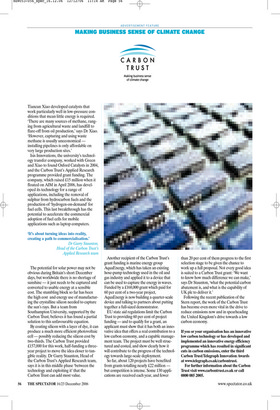‘It’s about turning ideas into reality, creating a path to
commercialisation.’ Dr Garry Staunton, Head of the Carbon Trust’s Applied Research team
The potential for solar power may not be obvious during Britain’s short December days, but worldwide there is no shortage of sunshine — it just needs to be captured and converted to usable energy at a sensible cost. The stumbling block so far has been the high cost and energy use of manufacturing the crystalline silicon needed to capture the sun’s rays. But a team from Southampton University, supported by the Carbon Trust, believes it has found a partial solution to this unfavourable equation. By coating silicon with a layer of dye, it can produce a much more efficient photovoltaic cell — possibly reducing the silicon cost by two-thirds. The Carbon Trust provided £157,000 for this work, half-funding a threeyear project to move the idea closer to tangible reality. Dr Garry Staunton, Head of the Carbon Trust’s Applied Research team, says it is in this middle phase ‘between the technology and exploiting it’ that the Carbon Trust can add most value. Another recipient of the Carbon Trust’s grant funding is marine energy group AquaEnergy, which has taken an existing hose-pump technology used in the oil and gas industry and applied it to a device that can be used to capture the energy in waves. Funded by a £168,000 grant which paid for 60 per cent of a two-year project, AquaEnergy is now building a quarter-scale device and talking to partners about putting together a full-sized demonstrator.
EU state aid regulations limit the Carbon Trust to providing 60 per cent of project funding — and to qualify for a grant, an applicant must show that it has both an innovative idea that offers a real contribution to a low carbon economy, and a capable management team. The project must be well structured and costed, and show clearly how it will contribute to the progress of the technology towards large-scale deployment. So far, about 120 projects have benefited from grants totalling nearly £22 million but competition is intense. Some 130 applications are received each year, and fewer than 20 per cent of them progress to the first selection stage to be given the chance to work up a full proposal. Not every good idea is suited to a Carbon Trust grant: ‘We want to know how much difference we can make,’ says Dr Staunton, ‘what the potential carbon abatement is, and what is the capability of UK plc to deliver it.’ Following the recent publication of the Stern report, the work of the Carbon Trust has become even more vital in the drive to reduce emissions now and in spearheading the United Kingdom’s drive towards a low carbon economy.
If you or your organisation has an innovative low carbon technology or has developed and implemented an innovative energy efficiency programme which has resulted in significant cuts in carbon emissions, enter the third Carbon Trust/Telegraph Innovation Awards at www.telegraph.co.uk/carbontrust.
For further information about the Carbon Trust visit www.carbontrust.co.uk or call 0800 085 2005.






































































































































 Previous page
Previous page